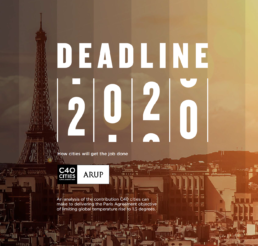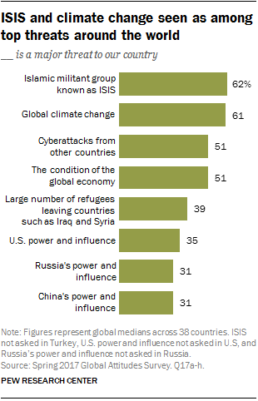by Erik Rasmussen
We are all stuck in a “Bermuda Triangle” – a dangerous combination of political, scientific and societal forces that are blocking progress on climate action and the Sustainable Development Goals.
What did we learn from hurricane Harvey and Irma? Scientists, politicians, the media and experts are already debating the answer to that question. How much of the catastrophe was caused by accelerating climate change? Was it another wake up call to a new reality – or just a cocktail of coincidental events? When we finally know the answer, it may be too late. The risk is that global warming is outpacing scientists and outdating their research. Consequently, we are collectively taken by surprise and respond too little and too late.
A study from Carbon Disclosure Projects shows that cities across the globe fear to become the next Houston. Among 103 cities, 76 percent reported that they are currently or will soon be facing the risk of flooding. Fundamental questions remain: Have we ignored all the warnings and tried to normalize them for too long? Are we running out of time?
The hidden warnings
Two reports released this summer paint a truly alarming picture of the global challenges we urgently need to solve. But I doubt that many people have read or heard of them.
“2020: The Climate Turning Point” is one of the reports. Written by a group of internationally renowned scientists from respected institutions, it was presented in “Nature” on June 29 with a very clear message: We only have three years to limit and control global warming. If we fail, we could lose all possibilities for keeping the rise in global temperatures below 2 degrees Celsius and risk uncontrollable consequences.
The second report is the “The Sustainable Development Goals Report 2017”, which was released by the UN in July. It includes reported progress from countries the world over, and is a distressing read. We are significantly off track to reach the Goals by 2030. In the report’s foreword, the UN General Secretary António Guterres proclaims: “Implementation has begun, but the clock is ticking. This report shows that the rate of progress in many areas is far slower than needed to meet the targets by 2030.” The report documents that even though we have made some progress, it represents only small steps on the long path towards a sustainable future. The recommendation is clear: We need to act now and fast.
The same conclusion is drawn in a comprehensive analysis of the development in megacities. Published by the city network C40, the report is dramatically titled “Deadline 2020” and indicates what kind of challenges cities are confronted with. It concludes that cities have to slash CO2 emissions drastically within the next three years. If they fail to do so, they will not be able to meet the targets set forth by the 2015 Paris Climate Accord. Taking in consideration that cities account for one- third of all global greenhouse gas emissions, it is a serious warning.
A growing number of other studies and reports present equally bleak predictions for the future, always with the same message: We can still avoid the most horrifying consequences of key global challenges such as climate change, but it requires unprecedentedly fast and interconnected action by governments, businesses, investors, cities and civil society – including the individual citizen.
A study from Carbon Disclosure Projects shows that cities across the globe fear to become the next Houston. Among 103 cities, 76 percent reported that they are currently or will soon be facing the risk of flooding. Fundamental questions remain: Have we ignored all the warnings and tried to normalize them for too long? Are we running out of time?

Last Call
Previously, we have relied on 2030 – or approximately 5,000 days – as the deadline for reaching the SDGs. This time horizon provided us with a small but reasonable window. Yet with these new reports, we have a new deadline, which leaves us with only 1,000 days to regroup and make the transitions necessary to be able to control our climate and get on track to solve global risks. The reports all have the ingredients of a blockbuster thriller: We are dangerously close to losing control of our own future, and the actions necessary to regain it require interventions on a scale that will trigger political, economic, and mental unrest. So far, the political transformation has not been impressive but rather inadequate and constrained.
We can conceptualize this as a “Bermuda Triangle” of our knowledge society. The Bermuda Triangle describes three reasons why knowledge disappears and fails to spark change.
1. Incomprehensible reports
Research has shown that only about 15 percent of international reports are read. That number also applies for the group of officials who need the reports to make decisions. This is not a surprise considering that most reports are downright unreadable, as they succumb to the technical and complex jargon of the elite. One study published in the magazine Nature concludes that the UN climate reports, for example, are becoming increasingly incomprehensible. Sadly, the media are of little help. They are either too disinterested or too unskilled to bring to light the mesmerizing dramas hidden in the complex paragraphs and cryptic graphs.
The biggest news often attracts the smallest headlines – if any headlines at all. The paradox is the fact that the most important knowledge of humanity is not understood by humanity, but only by a handful who fails to act accordingly. This could spark a reinforced rebellion against the elite and ruling class (politicians, business leaders, investors and the media) the day humankind is forced to rapidly and radically change living conditions because of accelerating global warming.
The public debate has pushed this reality aside in favour of smaller, more immediate challenges, because the predominant belief is that ‘we can deal with it later’. This ‘later’ is now just a matter of 1,000 days.
We can conceptualize this as a “Bermuda Triangle” of our knowledge society. The Bermuda Triangle describes three reasons why knowledge disappears and fails to spark change.
2. Scientific disagreements
Unfortunately, it has become too easy to challenge the experts, particularly in a time which fake news are overshadowing real news and credibility is constantly put into question. For example, a solid climate change consensus represented by over 97% of scientists is being misreported as the opposite: a great divide in the scientific community. The supposed lack of consensus suddenly becomes more important than communicating the most trustworthy information. Particularly the UN’s climate reports, known as the IPCC reports, have fallen prey to this tendency.
Because these studies have to be supported by such a wide variety of scientists with different nationalities, backgrounds and beliefs, their conclusions become vague and unspecific with little respect of the state of the world’s climate. This means that the researchers continuously have to update their climate change prognosis because change happens at a quicker rate than the reports had predicted. For example, ice has been found to melt faster at the poles than expected and weather events have proved more extreme than anticipated. We are yet to hear any scientific report that claims the opposite.
I found it interesting to witness the scientific debate in the aftermath of a controversial article “The Uninhabitable Earth“, which ran in June in The New Yorker magazine. In this piece, expert David Wallace-Wells describes a world which in the foreseeable future will be virtually uninhabitable, if we fail to cut emissions. In the article, he grasps a world with a global temperature rise of 4-5 percent and above and describes possible scenarios. These scenarios are quite scary and bring to mind apocalyptic movies such as “The Day After Tomorrow”. The article was criticized by a number of climate scientists who deemed it too extreme and doomsday-like. However, these scientists had to concede that the numbers were indeed correct, and that these scenarios would be possible if not likely.
This is an interesting example as it really shakes our sense of reality. According to his critics, Wallace-Wells’ fault was that he extended reality rather than questioned it. Science was completely on his side.
In a time where scientists have to constantly reassess their results and prognoses, it is up to any of us to choose which predictions to believe, and how far we are willing to take them. It raises the questions of how the general public become aware of the forces that are shaping our future, and how we as individuals can contribute to avoid sudden and unpleasant consequences.
3. Political resistance
The impression of expert disagreements makes it easy for politicians to pick and choose the ‘truth’ that best corresponds to their political beliefs – and attractive for them to do so.
If we have to create a breakthrough within the next 1,000 days, as the experts predict, we must dissolve well-established political agendas and deeply rooted economic philosophies. It goes for everything from our society’s economic growth to our consumer patterns. Decision-makers would be forced to take significant action if transitions were to be implemented within the near future. It will be unpopular and possibly cause massive protests from every stakeholder group from business to civil society. Therefore, it is much easier and convenient for the politicians to dismiss the hard decisions by pointing to scientific disagreements and then subscribe to the views of whoever expert best fit their established political agenda.
However, this attitude could prove to be out of touch with the expectations of the public. Humanity already seems more worried about the state of the world than politicians do. In the beginning of August, the American Pew Research Center published a study, which reveals that the world’s population rates climate change and Islamic terrorism as the two biggest political threats. The study finds that 62 percent fears terrorism, while 61 percent cities climate change as the greatest threat. In comparison, 51 percent expresses concerns over cyber attacks and the state of the world economy, and only 39 percent believes that the refugee influx is the biggest political security issue.
Despite regional differences, climate change is high up on the list of the biggest global risks in most countries in the world, and this fact further increases the possibility of a widening gap between the elite and the public. The prospect of swift interventions to reduce the effects of otherwise predictable catastrophes provides a dangerous recipe for potentially triggering uproar and divide in otherwise well-functioning societies.

It is for us to decide
The theory that the next 1,000 days can decide our future has less to do with doomsday predictions but more to do with the necessity to face reality and act upon it. This entails dismantling this ‘Bermuda Triangle’. It requires decision-makers, the media, and all thought leaders who have influence on the political agenda, to acknowledge their responsibility. The saying “now or never” has never been more relevant than it is today.
In fact, it seems natural to draw an unusual parallel to the landing operations of the Allies in Normandy, in June 1944 during World War II. If we had succeeded then, we would not have won the war but merely avoided losing it. It is the same case now: If we successfully transform and align climate action within the next 1,000 days, the world will not win the climate battle but merely avoid a fatal loss. 2020 is the D-day for humanity. It is now up to each and every one of us to take action
Sustainia will be in New York City for Climate Week NYC next week to gather international leaders from business, government and civil society, and renew the climate action momentum at this critical time. Follow us on social media and track #cities100 to learn about our new report on sustainable city solutions.

